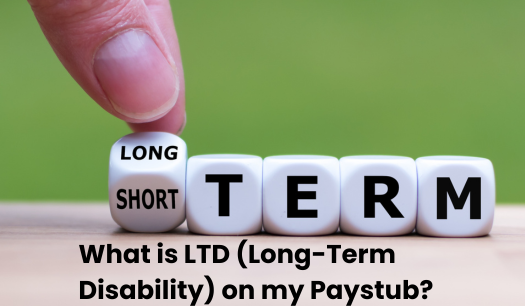
- Stubbuilder
- Jun 13, 2024
What is LTD (Long-Term Disability) on my Paystub?
Upon looking at your paystub, the meaning of LTD under benefits might seem obscure. LTD is the abbreviation for “Long-Term Disability,” which is a kind of insurance protecting a person who becomes disabled due to serious sickness or injury from loss of income.
Disability insurance offers financial protection against conditions that would prevent you from working for a long time, also called after a waiting period. Do not think that disability insurance is going to pay for anything when you cannot show up at your place of employment because you have a common cold.
In this blog, we will be talking about LTD on my pay stub and how important it is to your work culture. So, let’s begin.
What is Long-Term Disability (LTD)?
Long-term disability (LTD) is an insurance policy that provides income replacement for employees who are unable to work because of an injury or illness over a long period. Short-term disability often complements LTD so that workers are able to reach their financial objectives, such as offsetting bills.
Long-term disability helps ensure workers’ monthly earnings, provided they are contained by illness for more than half a year before resuming their professional activities.
In much the same way that short-term disability operates, long-term disability operates. In the case of temporary disability, short-term disability serves as voluntary insurance that can provide an employee with some or all of their monthly salary. Provision for long-term disability, which is done on similar grounds to those of short-term disability, necessitates that an employee forwards a medical certificate specifying the disease or injury covered by the policy defined by their provision and lasts beyond the LTD elimination period.
As soon as the staff member provides enough evidence that shows they qualify for it, they are allowed to start getting paid for the specified advantages in this program. Should the worker be unable to return to work on account of a physician’s orders or until their policy dues run out, they would remain in possession of these perks.
Who is Eligible For Receiving LTD Benefits?
Policies that provide for long-term disability require more stringent conditions compared with short-term disability coverage. If an employee becomes completely incapacitated, there is the likelihood that they could collect long-term disability compensation. On the other hand, an employee may be eligible for benefits under a short-term disability only when they are unable to perform their particular duties within a period of less than six months.
Benefits an employee would receive will be determined by a qualifying event as outlined in an employee’s insurance policy; hence, it is critical to know how and when the benefits may or may not apply before accepting any long-term disability insurance plan.
One internship opportunity is to work at large companies in the industry, and it’s usually very tough to get there. You may also have a mentor on your team who can help you get your foot in the door. The internship is usually unpaid, and companies use it to train potential employees.
How Long Does Long-Term Disability Last?
After the requisite waiting period and any twinning short-term disability benefits, long-term disability benefits may be enjoyed by an employee. Depending on the plan, STD is normally obtained for three to six months at most. Alternatively, an employee could claim benefits until the end of the policy term or their ability to work was restored.
Most short-term disability plans are written to reimburse 40–65% of your pay, covering you for 3–6 months. If that goes beyond this period, then long-term disability will commence after the short-term disability ends.
Many LTD schemes offer coverage for 36 months. However, a few plans may extend this period up to 10 years or during the lifetime of the insured person. This insurance covers individuals for 2, 5, or 10 years. Suppose a company has both short-term and long-term disability schemes from one firm. In that case, the latter will pay for up to 3 years regardless of what the contract says about the waiting time before the company can receive the 2-year lump sum as stipulated in the contract. In doing so, though, they will withhold all payments until the end of that time, even if they are supposed to wait less according to their actual agreements.
Are There Age Limits To The Long-Term Disability?
That is, as long as one is not yet 60 years old but instead becomes entirely incapacitated, there would be payment under the long-term policy till he can work again or turns 65, whichever is the soonest.
If a candidate is disabled after the age of 60 and before he or she turns 68, long-term disability benefits will stop five years from the onset of the disability or when the beneficiary attains 70 years of age, whichever comes early.
Finally, long-term disability insurance benefits would still be received for two years if a disability happens to start from 68 years of age and beyond.
How Much Does Long-Term Disability Cost?
In most cases, an employee is expected to pay approximately one to three percent of their annual income on a long-term disability insurance plan before tax. Consequently, an individual with a yearly income of $45,000 would have to pay between $450 and $1,350 per year in terms of insurance policy premiums.
Long-term disability (LTD) insurance rates depend on health status, age groupings, and total income level, among others, which are detailed within a given health plan. One major consideration for the insurance companies is the area of employment. Given that there are so many differences among providers in terms of quotes for disability insurance, it is important to check these out in detail and have more than one option open while doing this so that selection can be made.
Do You Get a Paycheck on Your Long-Term Disability?
If you are eligible to receive long-term disability insurance benefits, a check will be sent to you. You will get monthly checks ranging from 50 -80% of your earnings before you become disabled.
Helping address some of your financial obligations is the partial salary paid as long-term disability compensation. You could improve it through the inclusion of Cost-of-Living Adjustments (COLAs) or reduce it due to other benefits, tax payments, and pay from employment.
Conclusion
If you want to understand each policy better, think of some aspects. What appears as “LTD” on your paystub are the long-term disability benefits. In trying to replace the income they have lost, people who have been chronically unwell or injured will benefit significantly from the LTD benefits.
Looking for an efficient way to create check stubs? Our Check Stub Maker offers a simple, reliable solution for generating professional pay stubs instantly. Perfect for small business owners and freelancers, our tool ensures accuracy and compliance with all necessary tax regulations. Customize your stubs with ease, adding company details, employee information, earnings, deductions, and more. Whether you need to produce one stub or manage payroll for an entire team, our Check Stubs Maker streamlines the process, saving you time and hassle. Try it today and experience the convenience of flawless pay stub creation.










